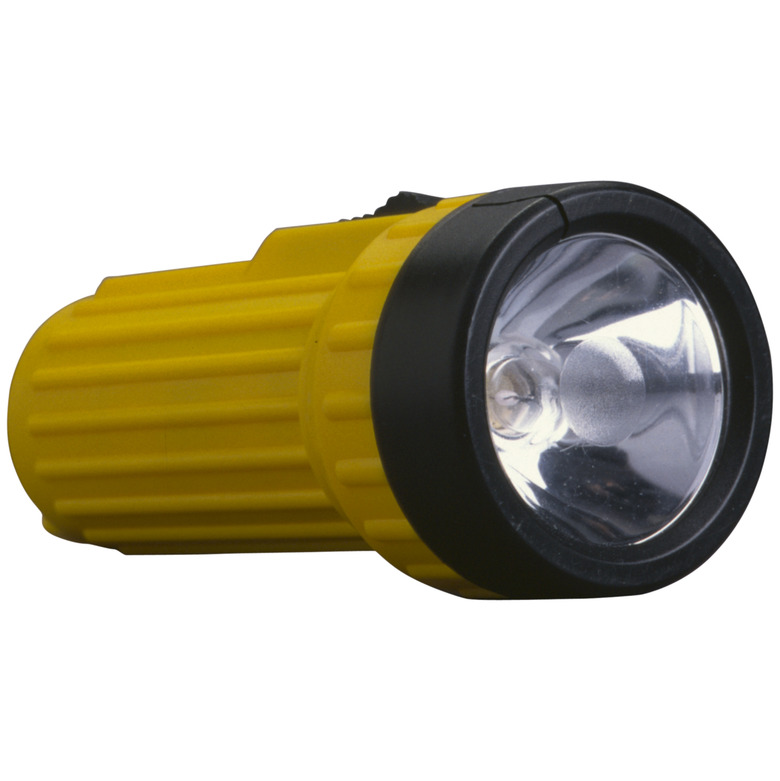How To Make A Parallel Circuit To Turn On Lights
Circuits can be wired using two methods: series or parallel. The preferred method and the type of circuit you find in your home lighting system is parallel wiring. This is because each light in a parallel circuit is independent of each other, so if a light bulb blows, the rest continue to work. It's relatively straightforward to make your own parallel circuit to turn on lights. Do it as an experiment with your kids, using flashlight bulbs and a battery. It teaches the basic principles of electric circuits in an interactive way.
Step 1
Place the cardboard on a work surface. This is the base for the parallel light circuit.
Step 2
Draw three 1/4 inch diameter circles on the cardboard with a pen. Draw the circles so they are equally spaced down the center of the cardboard.
Step 3
Use the tip of the pen or a knife and make a hole through the cardboard where you have drawn the circles. The holes need to be slightly smaller than the base of the flashlight bulbs.
Step 4
Push the three flashlight bulbs into the cardboard using your fingers so they fit fairly tightly. You need to push in the bulbs until only the glass part of the bulb is raised above the cardboard.
Step 5
Cut six 4 inch strips of AWG 18 gauge wire using a knife. Strip off 1/4 inch of the outer protective cover from the ends of the six wire strips using wire cutters.
Step 6
Turn over the cardboard so you can see the base of the three bulbs. Position your battery so it's just underneath the hole in the cardboard nearest to you. Cut strips of electrical tape and fasten the battery to the cardboard.
Step 7
Attach the end of one of the strips of wire to one of the terminals on the bulb furthest away from the battery. Use a small strip of tape to hold the wire in place. Attach a second strip of wire to the other terminal on the light bulb using the same method.
Step 8
Use a third strip of wire and twist one of the ends together to the opposite end of one of the strips of wire attached to the bulb. Use a fourth strip of wire and twist one end together to the opposite end of the other strip of wire attached to the bulb.
Step 9
Attach one of the twisted wires to one of the terminals on the second bulb and then attach the other twisted wire to the other terminal on the second bulb. Use small strips of tape.
Step 10
Twist the end of the fifth strip of wire to the opposite end of one of the wires from the second bulb and then twist the end of the last strip of wire to the opposite end of the other wire attached to the second bulb.
Step 11
Attach the two twisted wires to the two terminals on the bulb using tape as before. This means all the bulbs are connected and you have two loose ends nearest to the battery.
Step 12
Use a strip of tape and attach one of the two loose wires to the one of the battery terminals; it doesn't matter which one. Attach the end of the last loose wire to the other battery terminal. As you connect the last wire the bulbs will turn on and your parallel circuit is working.
Things Needed
- 12 by 12 by 1/4 inch cardboard
- Pen
- Knife
- 3 1.5 volt flashlight bulbs
- AWG 18 gauge wire
- Wire strippers
- 1.5 volt AA battery
- Electrical insulating tape
TL;DR (Too Long; Didn't Read)
You can easily wire a small switch between one of the wires connected to the battery and the bulb. This enables you to turn the lights on and off.
References
Cite This Article
MLA
Stevens, James. "How To Make A Parallel Circuit To Turn On Lights" sciencing.com, https://www.sciencing.com/make-parallel-circuit-turn-lights-10022209/. 24 April 2017.
APA
Stevens, James. (2017, April 24). How To Make A Parallel Circuit To Turn On Lights. sciencing.com. Retrieved from https://www.sciencing.com/make-parallel-circuit-turn-lights-10022209/
Chicago
Stevens, James. How To Make A Parallel Circuit To Turn On Lights last modified March 24, 2022. https://www.sciencing.com/make-parallel-circuit-turn-lights-10022209/
